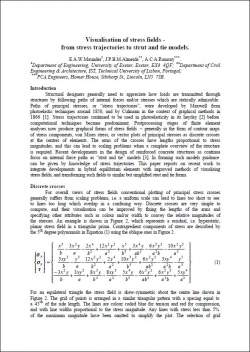Visualisation of stress fields - from stress trajectories to strut and tie models.
Authors
JPBM Almeida
Angus Ramsay
Edward Maunder
Abstract
Structural designers generally need to appreciate how loads are transmitted through structures by following paths of internal forces and/or stresses which are statically admissible. Paths of principal stresses, or “stress trajectories”, were developed by Maxwell from photoelastic techniques around 1850, and by Culmann in the context of graphical methods in 1866. Stress trajectories continued to be used in photoelasticity in its heyday before computational techniques became predominant. Postprocessing stages of finite element analyses now produce graphical forms of stress fields – generally in the form of contour maps of stress components, von Mises stress, or vector plots of principal stresses as discrete crosses at the centres of elements. The arms of the crosses have lengths proportional to stress magnitudes, and this can lead to scaling problems when a complete overview of the structure is required. Recent developments in the design of reinforced concrete structures as continua focus on internal force paths as “strut and tie” models [3]. In forming such models guidance can be given by knowledge of stress trajectories. This paper reports on recent work to integrate developments in hybrid equilibrium elements with improved methods of visualising stress fields, and transforming such fields to similar but simplified strut and tie forms.
Useful Links
Project: Stress Trajectories





